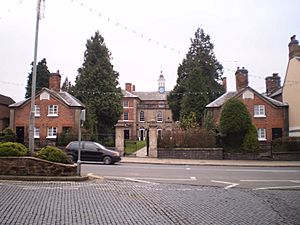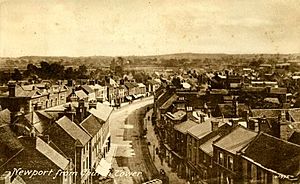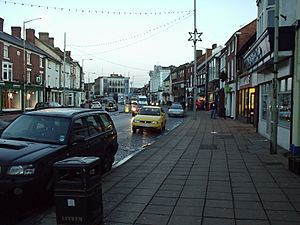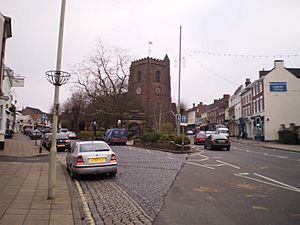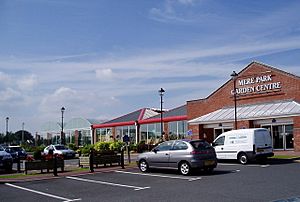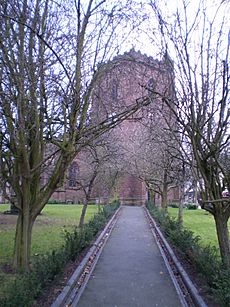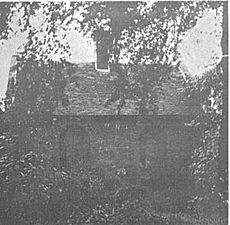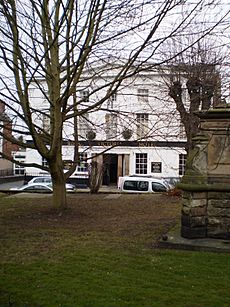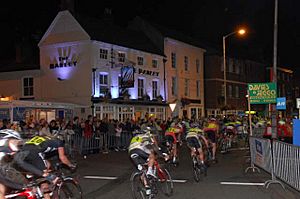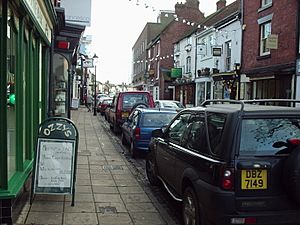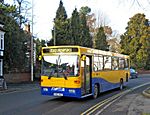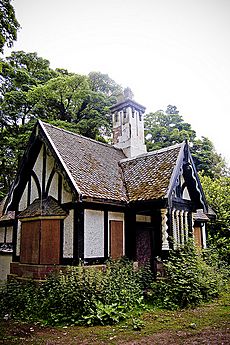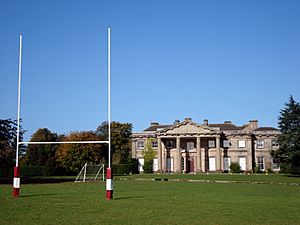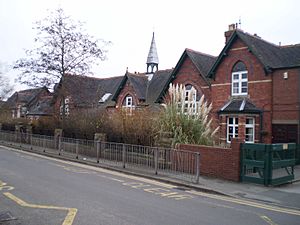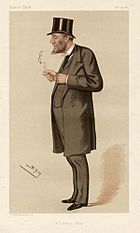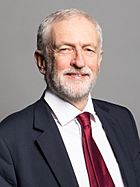Newport, Shropshire facts for kids
Quick facts for kids Newport |
|
|---|---|
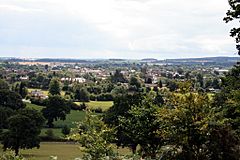 Newport from Cheney Hill |
|
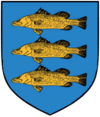 Coat of arms of Newport |
|
| Population | 11,387 (Newport parish) |
| Demonym | Novaportan |
| OS grid reference | SJ745191 |
| • London | 148 mi (238 km) SE |
| Civil parish |
|
| Unitary authority | |
| Ceremonial county | |
| Region | |
| Country | England |
| Sovereign state | United Kingdom |
| Post town | NEWPORT |
| Postcode district | TF10 |
| Dialling code | 01952 |
| Police | West Mercia |
| Fire | Shropshire |
| Ambulance | West Midlands |
| EU Parliament | West Midlands |
| UK Parliament |
|
| Website | Official website: http://www.newportsaloptowncouncil.co.uk |
Newport is a constituent market town in Telford and Wrekin in Shropshire, England. It lies 6 miles (10 kilometres) north of Telford and 12 mi (19 km) west of Stafford, and is near the Shropshire-Staffordshire border. The 2001 census recorded 10,814 people living in the town's parish, By the 2011 census, the population had risen to 11,387.
Contents
Naming
The Normans planned a new town called Novo Burgo between the older settlements of Edgmond and Plesc, near the Old Quarry and Mere Park garden centre. The first market charter was granted by Henry I, and over time the name changed from Nova Burgo to Newborough and finally to Newport.
Location
The site was chosen partly because of its location near the Via Devana (Roman Road, which ran from Colchester to Chester), and partly because of the number of fisheries (which are mentioned in the Domesday Survey). The River Meese, which flows from Aqualate Mere, lies to the north of the town.
Newport sits on a sandstone ridge on the eastern border of the Welsh Marches and west of the Aqualate Mere, the largest natural lake in the English Midlands The area around it at the end of the last Ice Age was part of Lake Lapworth. Formed from melting glaciers, it covered a vast area of North Shropshire. Early man fished here and two ancient log boats were uncovered 1 mi (1.6 km) from Newport. One has been preserved and is kept at Harper Adams University at Edgmond.
The villages of Church Aston, Chetwynd and Longford are adjoined to the south of Newport, though they remain in separate parishes. The village of Edgmond is located just to the west, separated by Cheney Hill, Chetwynd Park and the Shrewsbury and Newport Canal.
Like many rural market towns, Newport was influenced by industry; it served the needs of the mining area to the east of Shropshire and was also affected by mass produced industrial goods that replaced traditional crafts.
History
Newport is located in the historic kingdom of Mercia, near where Wreocensæte, capital the Wrekin, was once situated. Humans inhabited this area long before the creation of the town. Once established, Newport became a market town in the centre of the rural farming area between Stafford and Shrewsbury.
Saxon Times
In Saxon times there were two settlements in the location of the modern day town. The first, Eastun, has been identified as Church Aston and the second, Plesc, lies south of the town near the Mere-park Garden centre. In 963AD, Plesc was described as having a High Street, a stone quarry, and a religious community. The name Plesc means "fortified place" or "one with a palisade", suggesting that it was of some importance in the local area. Few signs of the Saxon settlement exist today, apart from the Quarry, which has now been built around.
Norman Times
At the time of the Norman Conquest, the land where Newport sits formed part of the manor of Edgmond, which William I gave as a gift along with the county of Shropshire to Roger, Earl of Shrewsbury. Henry I founded the borough, first called Newborough, after the manor came into his hands from Robert de Belesme.
Newport was omitted from the Domesday Book, but this is not uncommon. Other towns omitted include London, Tamworth, Oswestry and Ludlow, all boroughs since Saxon times.
The Normans planned the new town around the older one during the reign of Henry I. The wide main street was designed for its market, and the narrow burgage plots running at right angles to it are typical of Norman architecture and planning, though today only Guildhall and Smallwood Lodge are clear signs of Norman buildings, due to the 1665 fire which destroyed most of the High Street.
Medieval Newport flourished with trade in leather, wool and fish. Novoportans possessed the right to provide fish for the Royal table. The many half-timbered buildings surviving from the Late Medieval and Tudor periods confirm Newport's success, leading to the first market charter which was granted by Henry I.
The town is mentioned once by Leland in a list of castles, though now no visible remains of the castle exist; however, the most probable location for it would have been the traditional site of a manor house at Upper Bar, where there is a fragment of a square, broad moat, or on the higher ground along the Forton road, where the Castle House school stands. As regards the moat, nearly square, forming by measurement an area of 60 sq yds., two sides have been filled with rubbish. Nothing is known about the occupants of the moated site. It could have pre-dated the town or, perhaps more likely, could have been the manor house of the Audleys, who were granted the manor in 1227. By 1421, the manor house was in ruins.
One of the main reasons for Newport's early wealth was the surrounding fisheries and the chief service of the burgesses, being that of taking fish to the Royal court wherever it might be. This custom was continued after Henry III had granted the borough, with the manor of Edgmond, to Henry de Audley, but in the middle of the 13th century James, son of Henry de Audley, granted that the burgesses need not take the fish anywhere except within the county of Shropshire.
The burgesses received certain privileges from Henry I, since Henry II, in an undated charter, granted them all the liberties, rights and customs that they had enjoyed in the time of Henry I, including a guild merchant, which is mentioned in the Quo Warranto Rolls as one of the privileges claimed by the burgesses. Confirmation charters were granted by Edward I in 1287 and Edward II in 1311, while the town was incorporated in 1551 by Edward VI, whose charter was confirmed by James I in 1604. The governing body consisted of a Lord High Steward, deputy steward, two water-bailiffs and 28 burgesses, but the corporation was abolished by the Municipal Corporation Act of 1883, and a Local Board was formed, which, under the Local Government Act 1894, gave place to an urban district council.
Tudor Times
During his march from Mill Bay Pembroke to Bosworth Field, Henry Tudor spent the night of 18 August 1485 in Newport.
Regency Period
In 1665 many buildings were damaged in the Great Fire of Newport and only a few of the medieval structures remain. However, there remain many fine Regency and Georgian frontages, built on the site of the former Norman plots. This allows the main streets of Newport to be wider and less cluttered than those of the other towns of its age.
Edwardian Period
By the 19th century, Newport was surrounded by large estates that came right to the back door of the town, determining size and development. The vivary and open fields at Norbroom had gone making the town dependent on its rural hinterland. The few fields that remained were for hay or cattle, forming a small green belt. These estates exerted a powerful influence on the town, something obvious in the deference shown and respect paid to these landed families until at least the First World War.
Beginning in the south west of the town was the largest estate, the Lilleshall estate of the Duke of Sutherland. This dates from the dissolution of the monasteries, the lands of Lilleshall Abbey being purchased in 1539 by James Leveson of Wolverhampton.
The next estate is that in the south-east of Woodcote Hall, a smaller one belonging to the Cotes family.
On the west between Lilleshall and the town was the Longford Estate of the Talbots, Earl of Shrewsbury, sold in 1789 to Ralph Leake of Wellington who had made his fortune in the East India Company.
North of the town is the Chetwynd Park estate of the Pigots bought in 1803 by Thomas Borrow of North Derbyshire who changed his name to Burton Borough.
The Aqualate Estate to the east in lies mostly in Staffordshire.
20th century
The town was fortunate to avoid casualties during World War II when on Christmas Eve 1944, a V-1 flying bomb launched from a Heinkel bomber and aimed at Manchester landed in a field East of Newport, about 300 yards from the Newport to Gnosall road. This bomb is now on display at Royal Air Force Museum Cosford.
Modern Day Newport
From the 1960s very little in the way of redevelopment happened in the town, with attention going to surrounding towns including Wellington and Oakengates, which now make up the new town of Telford, but in 2007 the Telford and Wrekin Council borough towns incentive was brought about and the town received major investments over the following years, including a major redevelopment of the canal and surrounding area, the lower bar of the High Street area, planned housing, bars and restaurants set to line the canal. New sporting facilities, including a climbing wall in the Springfield's area of the town, were provided. The High Street and St Mary's Street area were seeing new stores coming into the town to fill empty lots and some of the older ones were developed.
In the spring of 2010 the first stage of the towns was a £1.5m regeneration began with the redevelopment of Victoria Park to the rear of The Royal Victoria Hotel, this cost between £250,000 and £300,000. The park had a new seating and new play area for along the canal front and a new car park closer to the town centre with plans to build a museum/information centre on the old car park.
The next stage of the regeneration, which was mainly focused on the High Street area of the town and Central square, involved re-surfacing the High-Street pavements and changing the design of the High Street around the Puleston Cross, removing the cobblestones and replacing them with paving and the traced outline of the 1850s market hall.
On Stafford Street next to the car park, some derelict buildings were demolished to make way for a retirement development, which made the entrance to the High Street area more inviting and on the entrance to the town by Mere park a care village is being built on empty fields that lead onto Stafford street, across from the £5m Premier Inn and Beefeater (restaurant) "Three Fish"
In July 2011, Telford & Wrekin Council unveiled massive plans for green land off the A518 bypass. The proposals included hundreds of new homes, a new supermarket, a business park and improvements to Burton Borough School.
House prices in the town are the highest in the TF post code area, (including the towns of Telford and Market Drayton) and amongst the highest in the county, due to high desirability because of the good local education establishments and easy commuting links to Birmingham, Telford, Stoke-on-Trent and Stafford.
The town is currently attempting to acquire Transition Towns and Fairtrade Town statuses.
Facilities and places of interest
The High Street
The main street in Newport follows the Norman design. This resulted in the distinctive long wide High Street, split into three parts, upper bar, lower bar and St Mary's street, with the centre of the high-street being the Puleston Cross and the 19th century Newport Market Hall completed in March 1860 and was built with an Italianate frontage, replacing an earlier building that was demolished due to fire.
Burgage plots ran along either side and the church rising up in the middle, with the High Street with St Mary's Street splitting off and re-joining the high street around the island on which are sited the St Nicholas Church and Butter cross, which is an ancient market cross.
After the fire of Newport in 1665 the old Norman buildings were replaced with grander Georgian architecture, which hid the work yards behind; the shops are still there but the work yards have now been developed into housing or the Boughey Gardens tennis courts, next to the literary institute. Despite being close to larger retail centres such as Telford, Shrewsbury and Stafford, Newport has retained a large number of shops that line the High Street, Stafford Street and St Mary's Street, with St Mary's Street keeping its charm by still using cobblestones and the majority of shops being small boutiques. St Mary's is also the site of various markets and fairs such as the Olde Time Market, with over 50 stalls, and various farmers markets; these tie in with Newport's indoor market. The town also has well known companies such as Subway, The Co-operative Food, Greggs, Coral, Costa Coffee, two Euronics centres and Mackay's, Bet365, Barclays, Lloyds TSB, HSBC, Boots, Halifax (United Kingdom bank), National Westminster Bank. There is a Waitrose superstore with a coffee shop and home delivery service on the edge of the town centre adjoining the Stafford Street car park. The towns Woolworths store was developed into a B&M Bargains and a Jaspers bakers store opened in an empty store nearby.
On the Newport by-pass near to the Aqualate Mere the A518 road an out-of-town shopping centre has grown up around the Mere Park Garden centre. The building work is still being extended and hotels and small shops being built; this ties in with the various other industrial estates that lie around the Newport by-pass and Springfield estate, this would also be the site of the new train station if Stafford Council and Telford and Wrekin councils agree terms to connecting train service between Telford, Newport and Stafford and where the park and ride service is set to go from in a triangle of the three main shopping centres of the town: Mere Park, Audley avenue business park and the High street.
Other areas
The oldest man-made landmark in the town is the Puleston Cross which is a butter cross positioned near to the Church of St Nicholas. This is an early 14th century cross denoting a market place and named after Sir John Puleston who lost his life during the reign of King Edward I in campaign against Wales.
Towards the top end of the town is the Combat Stress centre, built in 1908 as the infirmary for the Newport Workhouse, it was subsequently developed as accommodation for elderly ladies until its closure in 1995. The home was purchased in 1996 and totally refurbished to provide 31 bedrooms, two of which can provide carer facilities. Set in three acres on the edge of Newport, it has easy access to all local facilities.
The town sits near the Aqualate Mere, which is the largest natural lake in the English Midlands.
-
St. Nicholas church & Newport war memorial
Religious sites
The first recorded religious community is 963 AD where a Saxon script recorded a religious community. This was the church of St Mary Magdalene, built in the time of Archbishop Dunstan.
Newport lies in the Church of England Diocese of Lichfield and the Roman Catholic Diocese of Shrewsbury and as a Norman planned new town, religion played a strong part in the design of the town, with the centre of the town being dominated by St Nicholas Church, originally built in the reign of Henry I and restored in 1886 and 1890.
The second church of the town is the St Peter and Paul Catholic church in Newport Salters Lane, built 1857 and the oldest Catholic church in Shropshire, designed by Augustus Pugin.
Lilleshall Abbey ruins are to be found 4 mi (6 km) from the town centre. They include a Norman west door and part of the front, considerable remains of the church besides, and traces of domestic buildings. The abbey was founded in 1145, under charter from King Stephen, by Richard de Baumes or Belmeis, dean of St Alkmund, Shrewsbury, for Augustinian canons, who were brought from Dorchester Abbey, Oxfordshire.
A smaller church for the Baptist community sits at the back of The Royal Victoria Hotel in water lane, called Newport Baptist church, which was built in the 1960s.
The town has had a wide range of religious sites over time and this is shown in the number of churches in the town, the Independent Chapel, Beaumaris Lane, Newport, built 1803 on the site of a church dating from 1765, converted into cottages in 1832 when they finished work on the new church, the Newport Independent (Congregational) Chapel, Wellington Road, built in 1831, subsequently becoming part of the United Reformed Church. It merged with the Methodist Chapel in Avenue Road in 2001 to become Trinity Church, a joint Methodist/United Reformed Church. A major renovation was undertaken in 2010.
Due to the growth and decline of religions over time some previous churches have since been used for other uses or been demolished altogether, most of these are in the Upper Bar area of the town, around the Granville road and Wellington road area.
Near to the Trinity church is the Newport Primitive Methodist Chapel, built 1877, closed 1920 which replaced the one built in Stafford Road, built 1830, demolished 1877. The latest one is now a shop and bar.
Two more former churches are the Newport Wesleyan Methodist Chapel, Upper Bar, built 1829, which was turned into a shop and theatre in 1876 and the Wesleyan Methodist Chapel in Avenue Road which was built in 1876 and closed in 2001 on merging with the Wellington Road URC Chapel; it subsequently became a gym but has since been converted into a house.
- Newport General Cemetery was opened for burials on 2 March 1859 with its first interment taking place on 5 March 1859 when it is noted that some 1,000 people witnessed the burial. The cemetery contains a chapel built at the same time and is bounded at the public road side by fine wrought iron railings and gates. The cemetery was originally laid out with four oval lawns around a cross-shaped set of roads with the chapel centrally placed. Also buried in the cemetery are eleven British Army soldiers of World War I and a soldier and airman of World War II, who are commemorated by a row of Commonwealth War Graves Commission headstones.
Culture
Events and venues
Newport has a wide range of different activities throughout the year and is fast becoming a Cultural centre in the area, due to the large amount of venues and areas that can support activities, this is also helped by the beauty of the town and surrounding Shropshire country side.
The most used Venues in the town are scattered mainly along the High street, starting in the lower bar by the Shrewsbury Canal is the Newport Cosy Hall which is used for the Newport music festival along with The Royal Victoria Hotel in St Mary's Street which was named after Princess Victoria in 1832 after she stayed at the hotel.
The Guildhall is a medieval timber-framed building that is the home to Newport Town Council and is used for official purposes as well as smaller events. Newport Market Hall built in 1860 and is considered one of the towns grandest buildings and is the location of the towns dance hall, though not used in recent times.
Newport has a lively night life for a town of its size, mainly due to the students from the Harper Adams University College along with other students from Newport. The night-life is at its most lively during the weekends, as well as Monday and Wednesday nights during 'term time'. Royal Naval Club is the venue that hosts live music from local and national bands.The New Inn also hosts regular Sunday Music Sessions with some talented visiting artists performing from 6pm twice per month. There is also a wide range of small pubs and wine bars spread up and down the main High Street of Newport, the most popular with locals being The Barley Mow, The Railway Tavern and The Pheasant, while Ozzys Wine bar in St Mary's Street was (formerly owned by rock star Ozzy Osbourne) Harper Bar, Beau bar and Adams House are popular amongst the sizeable student population. The town centre also boasts a nightclub, Central Square, which was formerly called "The Village", "Main Street", "Sommervilles" and The Vine Vaults". Locally, it is referred to as "Mainers".
| Wine Bar | Ozzys Wine bar - (formerly owned by Ozzy Osbourne) |
| Student Bar | Harper Adams Student union |
| High street (Upper bar) | The Railway Tavern · The Pheasant · The Shakespeare Inn |
| High street (Lower bar) | The Kings Head · The Bridge · The Swan |
| Hotels | The Royal Victoria Hotel · The Newport Arms Hotel |
| Off the high street | The Weatsheaf · The New Inn · The Aston |
| Edge of town | The Lion · The Lamb · Norwood House · The Fox · The Swan at Forton · The Honeysuckle, The Red House |
| Nightclubs | Central Square · The Barley |
| Members clubs | Newport Bowling club · British Legion · The Audco · Newport Rugby Club · Newport Cricket Club · Newport Naval Club |
Town events
The town hosts many events throughout the year, but six main events bring people to Newport, which are Newport Show hosted yearly at Chetwynd Deer Park and is the major annual event in the town, first held in Victoria Park in 1890 and now attracting 13,000 visitors each year. The show is now held at Chetwynd Deer Park between Edgmond and Newport. Newport Show has become one of the main agricultural shows in the county and West Midlands region due to its position near the town and size of the show ground, which also hosts British Falconry and Raptor Fair.
In the centre of town itself the main events are the Newport Carnival (Newport carnival), which has been staged in Newport for over 50 years and the Newport Old Time Market (Newport old time market) which happen yearly usually on either side of Newport Show in July, towards the end of the summer the newest event is the Newport Music festival which is hosted by various venues in the town. The biggest event in the town is the biennial Newport Nocturne Bike Race, which brings the biggest crowds to Newport and is well covered by national press and media outlets.
Also to note is 'The Pheztival' which is organised by local bands) and the Pheasant Inn at the August bank holiday weekend. The event attracts acts from around the country to raise money for MacMillan Cancer. In 2011, £1500 was raised by the event.
Restaurants and cafés
Newport has a wide range of restaurants, mostly on the High Street and branch streets. These range from family run cafés to international companies.
| Pub food | The New Inn · The Barley · The Swan at Forton · The Fox · The Lion · The Lamb · The Aston |
| Tea Rooms | The Lutine Bell · Smallwood lodge · Waitrose · Craft Cafe & Pop Up Shop |
| Take Away | Jones chip shop · Zach's Plaice · Spice Island · The Wan loi Chinese · China Palace · Newport Kebab House · Star Pizza & Kebab · Raja's · Combinations · Masala |
| Restaurants | The New Inn · Norwood House · Shimla Licensed Tandoori · Taste Of Paradise · The Three fishes · Subway · Shanghai City · |
- The Craft Cafe and Pop Up Shop on the corner of Wellington Road. Newport Visitor Information Centre is also located here.
- The Royal Victoria Hotel - a historical building dating back to 1830, first opened by the Princess Victoria and now operating as a hotel, bar and restaurant, now running rock and indie nights.
- Smallwood Lodge- A half timbered chocolate box building where Anne Boleyn, Henry VIII's second wife once stayed
- The Lutine Bell - a popular and long standing restaurant down an alley off the high street
- The town has two cheeses named after it: Newport and Newport 1665, both are made near the town along with Wrekin Blue and Wrekin White.
- In addition to cheeses, Newport and the surrounding area has a number of artisan food producers ranging from jam, relish and chutney to bakery products, all available from the Pop Up Shop in Wellington Road.
Transport
The town has been a well used crossing-point even before the creation of the settlement and sits on an historical crossing point of the Via Devana.
The town became prominent as a coaching town on the Mail coach route between London, North Wales and Ireland as well being on a historic junction on the road from London to Chester and the East Midlands. This meant that the town grew around the different roads that cross the town. At the centre of the town is a large island with the church of St. Nicholas at one end and Central Square nightclub at the other, the High Street on one side and St Mary's Street on the other side. The two streets come together at one end in front of the nightclub at the junction with the A518 from Stafford which runs through the town on an east–west route from Stafford to Telford. They come together at the other end by the truncated Shrewsbury and Newport Canal beyond which is the junction with the A519 road from Eccleshall and Stoke-on-Trent. At the southern end of the High Street is another junction where the A519 road leaves on its way to Telford.
Before the road network the canal was the main link into the town. It is not currently connected to the national network, but there are plans to restore it to a fully working canal by the Shrewsbury and Newport Canals Trust. linking into the national canal network at Norbury Junction to the east of the A41 which now borders the town to the east on a north–south by-pass route opened in early 1985 to ease the congestion that plagued the High Street.
The town sits 8.8 mi (14.2 km) from the M54 and 11.1 mi (17.9 km) from the M6 Motorways.
Buses
The town is served by buses between Stafford and Telford and a service from Shrewsbury. Arriva Midlands is the main service provider for the town with additional shoppers services operated by Wrekin Rider, the bus operating arm of Telford and Wrekin District Council.
Rail
The former Stafford to Shrewsbury Line once ran through the town, but due to cuts Newport (Salop) railway station was closed in September 1964 and has now been dismantled. The line has been restored to Hortonwood, and it is possible that the next phase could be to reconnect the town to the railway network. This has been given a boost by the town council, who are currently in talks with Stafford borough council to discuss the link to Stafford. The line is in the top 36 'Lines that should reopen' listing published by the Campaign for Better Transport, and with the Telford International Freight Park in Donnington, Telford needing better connections to the east coast and Scotland, this could mean a line going past the town and on towards Gnosall and Stafford.
Cycling
Newport is on National Route 55 and Regional Route 75 of the Sustrans National Cycle Network. Cycle maps for these routes are available from Newport Visitor Information centre, located in the Pop Up Shop on Wellington Road. The cycle way to Stafford runs on the former railway line and will be completed by the end of 2014.
Walking
The town sits on the Way for the Millennium walk way which is 65 km (40 mi) long, and heads toward Stafford, passing through several villages on the way.
Surrounding villages and hamlets
The town is surrounded by many different small villages, ranging from the larger settlements of Edgmond and Lilleshall to smaller hamlets all of which are joined to the town or separated only by a small distance; most of these settlements are seen as parts of the town's catchment zone and as Newport is on the Shropshire/ Staffordshire border many lie in South Staffordshire but their postal address is still Newport, these are as follows:
- Church Aston
- Chetwynd
- Longford
- Edgmond
- Moreton, Staffordshire
- Meretown
- Adeney
- Stockton, Shropshire
- Pave Lane
- Bromstead Heath (Staffordshire)
- Great Chatwell (Staffordshire)
- Forton, (Staffordshire)
- Coley (Staffordshire)
- Outwoods (Staffordshire)
- Wilbrighton.
- Tibberton
Closest cities, towns and villages
 |
Hodnet, Whitchurch | Hinstock, Market Drayton | Woodseaves, Eccleshall, Newcastle-under-Lyme, Stoke-upon-Trent |  |
| Edgmond, Tibberton, High Ercall, Shrewsbury | Gnosall, Stafford | |||
| Lilleshall, Telford | Shifnal, Bridgnorth | Albrighton, Wolverhampton, Birmingham |
Economy
Newport is the main hub for the farming community along the Shropshire/Staffordshire border and as a local business centre. The Football Association, Medical and Exercise Science Department is based at Lilleshall Hall on the outskirts of the town.
A large section of Newport's economy is based around education, two selective state schools and a large comprehensive drawing students from far beyond the town, as well as a university on the edge of the town along with a regional food academy.
Retail plays a major part of the economy of the town, with the majority of shops being located in and around the High street, with larger out of town stores located on the Audley Avenue and Springfield trading estates into the south of the town and to the east of the town the Mere park complex. tag
Sport and clubs
Newport Town FC play in the West Midlands (Regional) League (Division Two) and have a reserve side ("Edgmond Rangers") who play in the Mercian Regional Football League (Division Two). Newport Town were the league champions of the Shropshire County Premier Football League for the 2011–12 season, earning them promotion. Since promotion in 2012, the senior team now plays its home games at Harper Adams University College in Edgmond and the reserve team also play in Edgmond. Previously they played their home games at Shuker Field, a 3-acre (1.2 ha) field close to the Burton Borough School in Newport itself.
The Newport Crown Green Bowls club plays in the Premier Division of Shropshire after promotion from the Mid Shropshire division one as well as many other division and leagues.
Newport (Salop) Rugby Union Football Club is the highest ranked rugby club in Shropshire and the main club in the town
Newport Cricket Club plays in the Shropshire Premier Cricket League Premier Division.
On 2009, the £200,000 Newport Sk8 park was formally opened by Princess Anne. The skatepark is the largest in Shropshire and the largest W/ramp in Britain.
265(Chetwynd) Air Training Corps are also based just outside of Newport, on the Chetwynd Deer Park.
Lilleshall Sports Centre
Lilleshall Hall - formerly the country retreat and hunting lodge for the Duke of Sutherland, situated just 2 mi (3 km) from the centre of Newport and is now home to Lilleshall National Sports Centre.
Education
Newport has a full range of educational establishments, from primary schools to a university. The selective schools in the town are Newport Girls' High School and Haberdashers' Adams (previously known as Adams' Grammar School). Harper Adams University is located in the nearby village of Edgmond, and Keele University operates teaching rooms in the doctor's surgery for trainee student doctors. For Further Education students, the closest colleges to the town are Telford College of Arts and Technology and Stafford College, with Buses running from the town to both colleges and to Shrewsbury College of Arts & Technology. Just outside the town is Edgmond Hall, used by Sandwell Metropolitan Borough Council for outdoor activities for school students.
| Infant | Church Aston Infant School · Moorfield Primary School · St Peter & St Paul RC Primary School · Newport Infant School |
| Junior | Newport Junior School · Moorfield Junior School . Castle House School |
| Comprehensive (no sixth form yet - this has been proposed for a long time) | Burton Borough School |
| Secondary state grammar schools (with sixth form) | Newport Girls' High School & Haberdashers' Adams |
| Universities | Harper Adams University |
Notable residents
Early times
- Robert Puleston, (born in Newport) – brother-in-law and supporter of Owain Glyndŵr, against King Henry IV
- Richard Barnfield (1574 in Norbury, Staffordshire – 1620) – English poet, obscure though close relationship with William Shakespeare, brought up in Edgmond nearby.
- William Adams, (1585 in Newport – 1661) – London Haberdasher founded Haberdashers' Adams in 1656
- Thomas Brown (1662 in Newport or Shifnal – 1704) – satirist
1750–1900
- John Meeson Parsons (1798 in Newport – 1870) – art collector and director of the Shropshire Union Railway
- William Ick (1800 in Newport – 1844) English botanist and geologist
- James Brown (1812–1881) – Roman Catholic Bishop of Shrewsbury from 1851 to 1881, lived Salter's Hall, near Newport
- Arabella Elizabeth Roupell (1817 in Newport – 1914) – English flower painter
- James Hain Friswell (1825 in Newport – 1878) – English essayist and novelist
- Thomas Collins (1841 – 1934 in Newport) – played first-class cricket for Cambridge University from 1861 and 1863 and was headmaster of Newport Grammar School from 1871 to in 1903
- Charles Cecil Cotes (1846 Woodcote Hall – 1898) – British landowner and Liberal politician
- Colonel the Rt. Hon. William Slaney Kenyon-Slaney (1847–1908) – sportsman, soldier and MP for Newport 1886 to 1908
- Percy John Heawood (1861 in Newport – 1955) – British mathematician
- James Edward Quibell, (1867 in Newport – 1935) – Egyptologist
- Frederick Phillips Raynham (1893–1954) – office worker at Harper Adams College and pilot from the early days of aviation
from 1900
- Sir Peter James Bottomley (born 1944 in Newport) – British Conservative MP for Worthing West since 1997
- Peter Butler (born 1951 in Newport) – British Conservative MP for North East Milton Keynes from 1992 to 1997
- M. J. Bassett (born c. 1965 in Newport) – is an English screenwriter and film director of Solomon Kane
- Jeremy Corbyn, (born 1949) – Labour MP for Islington North since 1983, Leader of the Labour Party from 2015 to 2020. Lived as child in Pave Lane and attended Castle House School and Haberdashers' Adams
- Robert Hendy-Freegard, (born 1971) – barman in Newport, conman, impostor who masqueraded as an MI5 agent
- Stuart Meeson (born 1972 in Newport) – physicist in Electrical Impedance Tomography, went to school in Newport
- Craig Phillips, (born 1971) – winner of Big Brother 2000 lived in Newport
- James Sutton (born 1983) – is an English actor, best known for playing John Paul McQueen in Hollyoaks. Lived in Newport
Sport
- Herbert Denis Edleston Elliott (1887 in Newport – 1973) – English cricketer, played for Essex County Cricket Club
- Reuben (Ben) Jones (1932 in Newport – 1990) – an Olympic equestrian, competed in the 1964 Summer Olympics
- Paul Bracewell, (born 1962) – footballer for England, Newcastle United and Sunderland
- Adam Proudlock, (born 1981) – youth team coach for Newport Town, played for Wolves, Ipswich Town and Notts.F
- David Pallett (born 1990) – English darts player for Professional Darts Corporation lives in Newport
- Callum Burton (born 1996 in Newport) – English football goalkeeper for Shrewsbury Town F.C.
- Ben Rowlings (born 1996) – British Paralympic athlete who competes in the T34 classification, lives in Newport
Images for kids
-
Newport Guildhall, dating back to around 1400
See also
 In Spanish: Newport (Shropshire) para niños
In Spanish: Newport (Shropshire) para niños



